
News
Guillemot mortality after the MSC Zoe – the importance of long-term studies
During the night of 1 to 2 January 2019, the containership MSC Zoe lost no less than 342 containers just to the north of the Dutch Wadden Sea islands. Media reported extensively on the massive amount of marine litter from these containers and on the potential risks of dangerous cargo.

Our dossier paid attention to this major incident (messages of 11 January, 4 February, 1 April 2019) and a quick-scan report on potential consequences was produced (see downloads). Meanwhile, media attention has dwindled but potential consequences and research into such consequences are continued.
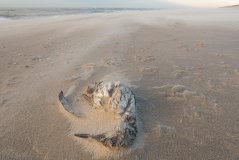
Guillemot mortality
Within two days after the container incident, reports started to come in on weakened and dead common guillemots on the Dutch coast. The mortality started in the north, but rapidly increased also further south and persisted into the month of February. A rough estimate indicated that possibly 20 thousand guillemots died close to the Netherlands. As this event almost paralleled the container incident in time and place, rumours quickly made a link with the containers and associated losses of toxic substances or plastics. But many other potential causes made it into the media, including persistent storms, food-shortage, bird flu, intestinal infections, discharges of paraffin etc.
The large mortality of guillemots in combination with the ship incident led to high media attention not only nationally, but also internationally.
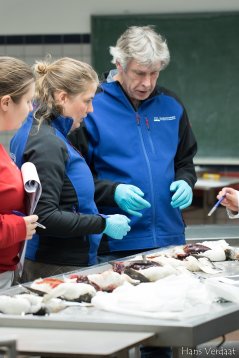
Research
The Marine en Bioveterinary institutes of Wageningen Research, the faculty of Veterinary Medicine and the Dutch Wildlife Health Centre of Utrecht University launched a major study of the guillemot mortality, financially supported by the Netherlands Ministry of Agriculture, Nature and Food Quality (LNV). With massive help of many volunteers, bird rehabilitation centers and Rijkswaterstaat RWS, 123 guillemots and 12 razorbils were brought together for a mass autopsy session in Utrecht on the 6th of February. In addition to the direct autopsy data (age, sex, condition etc.) many samples were taken of e.g. stomachs, intestines, and various tissues for detailed investigations.
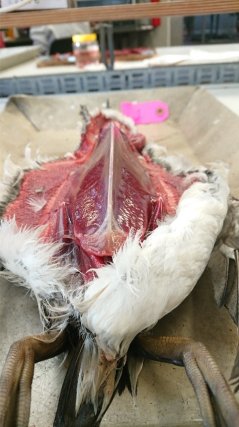
Results
The research had one clear conclusion: the guillemots starved without a relation to toxix substances of plastics from the container, no avian flu or other diseases, no paraffin or oil. For all details see the full report download option further down. ‘Starvation’ sounds important, but actually does not mean much as long as the reason behind the starvation is not known. Food availability or persistent stormy weather were not a clear background. Long-term research by the Beached Bird Surveyors of the Dutch Seabird Group (NSO-NZG) indicated that yes, this was an elevated level of guillemot mortality, but not highly exceptional in comparison to earlier examples of mass mortality. And yes, weather had been rough, but not extreme in comparison with many earlier winter periods. But then what could be the background of this mortality incident?
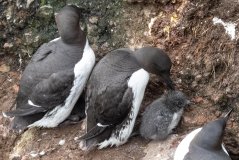
Fledging weight
Feather characters and ring recoveries indicated that the dying guillemots had their origin in nearby colonies in the North Sea, so mainly colonies in the United Kingdom. Most victims were aged as chicks from the previous breeding season. Thanks to long term studies on the Scottish Isle of May, by the Centre for Ecology & Hydrology (info Mike Harris), we learned that guillemot chicks fledged in 2018 had left the colonies at a low fledging weight (± 200g). From the long-term ringing studies at the Isle of May, it is known that such level of fledging weight is not extremely exceptional, but results in mortality of about 80% of guillemot chicks during their first winter. In other words, juvenile guillemots in the North Sea had a poor start of life in the winter of 2018-19. A moderate storm from the north became fatal for many of such poor condition chicks, as well as for the container ship MSC Zoe. Thanks to northerly wind directions, the consequences of both events became highly visible on the Dutch coasts. The cause of low fledging weights in 2018 is not well known, but good and poor years are a common phenomenon in the life of seabirds.
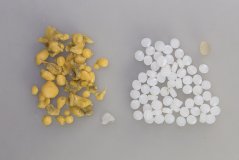
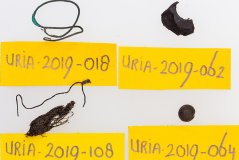
Plastics and paraffine
Thanks to the long-term monitoring study on northern fulmars we had the appropriate knowledge and experience to study the potential role of container related plastics in stomachs and guts of the guillemots. Also the presence of paraffin could be studied thanks to our earlier work on paraffin ingestion by fulmars. More than a quarter of the guillemots had plastic in the stomach but in small quantities and in no instance related to the plastic pellets, polystyrene foam granules or other plastics lost from the MSC Zoe containers. Paraffin-like substances were not seen in stomachs, but chemically demonstrated in feathers once, and in intestines twice. Clearly such substances should not be there, but figures do not show a role in the mass mortality.
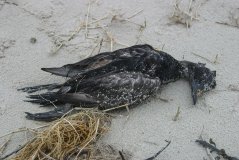
Follow-up research
In a later phase, stomach contents of beached fulmars and some other bird species will also be studied on potential presence of plastics that could be linked to the MSC Zoe containers. For the total Dutch Wadden Sea, we have support of RWS to ask our BBS surveyors and volunteers to collect not only fulmars, but also common scoter and eiders. From earlier work we have the experience that these marine ducks sometimes ingest plastic objects while searching for shellfish.

Long-term studies
A major conclusion from the guillemot study following the MSC Zoe incident is the importance of long-term studies in the marine environment. Oil pollution may no longer be our major environmental threat, and maybe the dutch phrase ‘olieslachtofferonderzoek (oil-victim-research)’ needs to be replaced by the more international wording of ‘Beached Bird Survey – BBS’. But the major benefit of this type of surveys can not be overrated. Our national BBS-system is the finger on the pulse to check the health of the North Sea, and offers the framework in which to view remarkable situations as in the recent guillemot mortality. Of similar importance are the Scottish long-term population studies and the continuous plastic monitoring at Wageningen Marine Research. Importantly, the indispensable role of volunteers in these types of projects must be highlighted with gratitude.
Download the reports:
- In Dutch: Baptist, M.J., Brasseur, S.M.J.M., Foekema, E.M., van Franeker, J.A., Kühn, S. & Leopold, M.F. 2019. Mogelijke ecologische gevolgen containerramp MSC Zoe voor Waddenzee en Noordzee - een quickscan. Wageningen Marine Research Report C029-19. Den Helder, 19pp.
- In Dutch but with English Summary: Leopold, M.F., Kik, M., Van Tulden, P., Van Franeker, J.A., Kühn, S. & Rijks, J. 2019. De Zoe en de zeekoet - een onderzoek naar de doodsoorzaak en de herkomst van de zeekoeten die massaal strandden op de Nederlandse kust in januari en februari 2019. Wageningen Marine Research Rapport C026-19. Den Helder. 59pp.